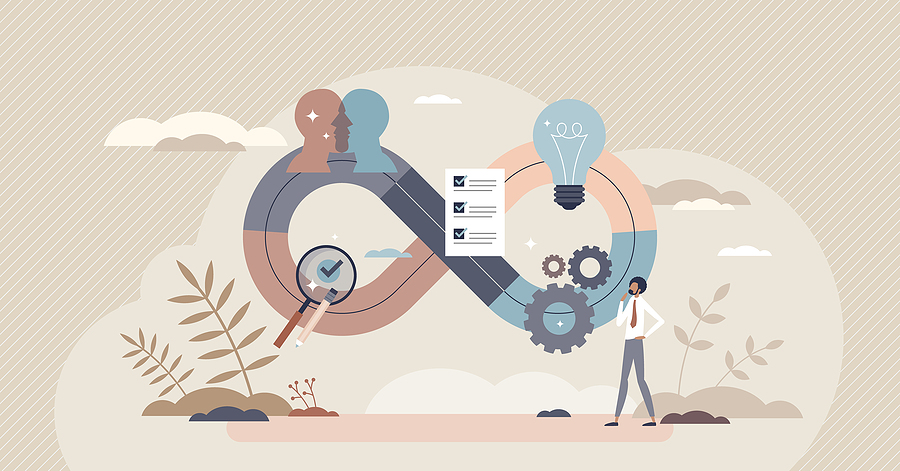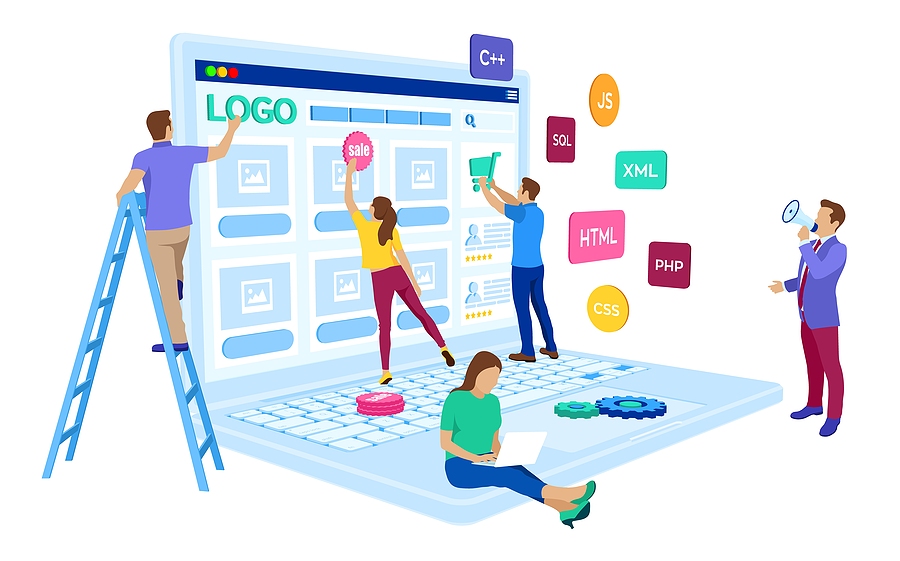10 Key Takeaways From the 2025 HubSpot Inbound Conference
Last month, Kevin (my husband and Wild Fig’s Chief Propeller Head) and I attended the HubSpot Inbound conference in San Francisco…and came home with...
5 min read
Kari Switala
:
October 28, 2025

Marketing has entered a new age—one shaped by artificial intelligence, real-time personalization, and continuous connection.
The old ways of grabbing consumer attention are no longer working. Traditional sales funnels don’t capture how people engage and buy today. Instead of following a straight path from awareness to purchase, today’s customer journey is cyclical, evolving with every interaction.
HubSpot’s new marketing playbook lays out a whole new way to build connections with customers and prospects. Read on to learn about Loop marketing: What it is, how it works, and how it can help you reach more customers in the age of AI.

Marketing and lead generation are changing…and fast. With the increasing use of AI and automation—and the evolving consumer expectations that have come with them—the old ways of reaching customers have quickly become outdated.
Instead of doing a Google search, then clicking on a link to visit a website, consumers now get their answers from AI—and even when they use Google, they get an AI overview. If you’ve noticed a big drop in website visits in recent months, this is why. Buyers don’t need to visit your website for information anymore.
This doesn’t mean optimizing your website is out. In fact, visitor intent is higher than ever.
Getting answers to basic questions from AI means that when a customer does visit your site, they’re much further along the buyer’s journey. According to the Loop Marketing Playbook we received at the recent HubSpot Inbound conference, “AI-referred traffic converts 4.4x better than traditional search”! A seamless website experience is vital to capture that traffic for your business.
What’s more, online customer attention is no longer focused solely on search. It’s spread across social media, podcasts, online forums, and dozens of other platforms. This means you need to shift gears from trying to own the conversation to building community and genuine relationships by connecting with consumers where they’re already spending their time.
It also means you need to have a unique point of view to share—otherwise, your voice will be drowned in the sea of AI-generated content.
You’ll also need to speed up your campaign planning. Six-month planning cycles are out: Short-term, agile planning is in. Experiment, then scale what works and cut what doesn’t. Rinse and repeat.
Enter: HubSpot’s Loop marketing.
 What Is Loop Marketing?
What Is Loop Marketing?Loop marketing reimagines the traditional sales funnel as a dynamic, customer-centric system. Rather than focusing on generating one-time conversions, it helps you build customer relationships that continuously generate value.
At its core, the Loop framework acknowledges that the customer journey doesn’t end with a sale. It circles back, creating a continuous cycle of engagement, optimization, and growth. With Loop marketing, HubSpot blends the principles of its groundbreaking Inbound marketing philosophy with next-generation AI technology to make this cycle both efficient and scalable.
This revolutionary new marketing concept focuses on optimizing four key stages that repeat and reinforce one another: Express, Tailor, Amplify, and Evolve.

Image credit: HubSpot Loop Marketing Playbook
The Loop marketing model is divided into four distinct—yet continuously connected—stages. They are:
Express your message and unique brand identity.
In this step, you define your taste, tone, and point of view, creating a style guide focused on your ideal customer profile. This guide can then be used to inform your AI tools with data, context, and a unique point of view, allowing you to create AI-generated content that more accurately reflects your brand.
Tailor your message to your audience. In other words: make it feel personal.
In this step, you use AI to make your customer interactions more personal, contextual, and relevant. And this goes well beyond plugging a customer’s name into an email. Using enriched data and real-time intent signals, you first divide your audience into targeted segments. Then, you can use behavioral insights to create highly personalized content that feels like it was written specifically for each recipient.
The goal is messaging that makes each audience member think, “How did they know that?”—not in a creepy way, but in a way that makes them feel genuinely understood.
Amplify your message across diverse channels.
In this step, you focus on engaging customers where they are—whether that’s on social media, in their email inbox, in search, etc. The goal here is to join the conversation that’s already happening and to meet your prospects on platforms where they’re already engaged. This includes partnering with voices your audience already follows and trusts, such as influencers, brands, and industry leaders.
This is also where you make sure your content is available and accessible to AI through GEO (Generative Engine Optimization—like SEO except for AI tools instead of search engines) so you show up in AI search. This can include running targeted, AI-generated ads, as well as creating content optimized for AI mentions.
Finally, make sure to engage buyers where their intent is highest by providing a seamless website experience. Once they hit your website, they’ll be ready to convert, so it should be easy for them to buy or connect with you. If they have to work to figure out how to do so, you’ll lose them.
Evolve your message in real time, using AI to quickly and effectively repeat the process.
In this stage, you utilize AI to spot early trends, run experiments, and continuously refine your strategy. This is more than just collecting data—you’ll immediately use that data to adjust your message. This is where your “loop” starts to take off: Each stage feeds into the next, ensuring your marketing never stops learning or improving.
For example, AI can help you track engagement and conversion signals in real time, so you can adjust your messaging accordingly. You can use this to predict which prospects are most likely to convert and identify weak spots in your message, so you can address them before you send your next campaign.
This approach involves constantly editing and adapting your message based on audience engagement. The benefits: Loop marketing delivers faster go-to-market, deeper customer connection, lower acquisition costs, and continuous optimization with AI that learns and improves with every campaign.

AI isn’t just a tool; it can be a powerful partner. With HubSpot’s Loop framework, AI takes on the heavy lifting—analyzing behavior patterns, recommending content, and identifying opportunities before they’re lost. It gives you a constant feedback loop between customer behavior and your response.
This matters now more than ever, because in the age of AI, personalization has become an expectation…not a luxury.
Businesses that continue to rely on static sales funnels risk losing customers after conversion; the Loop framework ensures engagement continues through retention, advocacy, and brand community—creating a self-sustaining engine for growth. It can help you:
…and ultimately, improve the ROI of your campaigns. The Loop framework allows even small businesses to compete at a higher level, with access to the same intelligent systems bigger brands use—without straining their resources.
The age of the static sales funnel is behind us: the future is a loop. HubSpot’s Loop marketing framework offers a smarter, more sustainable way to grow—one that mirrors how today’s customers actually search, connect, and buy. It provides a continuous, evolving loop powered by insight, connection, and AI innovation.
HubSpot’s tools to power this new marketing strategy are coming soon. For now, here are two things you can do to get ready for this new age of marketing:
Noticing these gaps now (and making any changes you can to improve) will help you hit the ground running once HubSpot’s tools go live. From there, you’ll be able to start integrating AI-driven recommendations, measurement dashboards, and automation tools that replace old static steps with fluid loops.
Want to be the first to know when HubSpot’s new tools are live? You can sign up for their list here.
Not hooked up with HubSpot yet? As an official HubSpot partner, the Wild Fig team is here to answer your questions, determine which level of HubSpot is right for you, and make sure you’re getting the most out of your HubSpot subscription. Schedule an exploratory call to get started!
-1.png)
Last month, Kevin (my husband and Wild Fig’s Chief Propeller Head) and I attended the HubSpot Inbound conference in San Francisco…and came home with...

What’s the deal with HubSpot Credits? (*cue Seinfeld*)

Have you been thinking about building a website for your business?